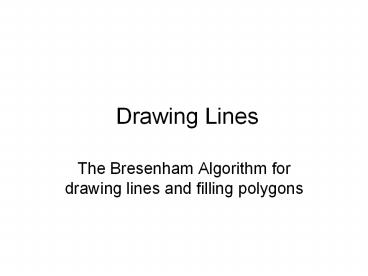Drawing Lines - PowerPoint PPT Presentation
Title:
Drawing Lines
Description:
It was originally to be used with a plotter. It adapts well to raster 'scan conversion' ... Scan conversion. The actual line is comprised of points drawn from ... – PowerPoint PPT presentation
Number of Views:34
Avg rating:3.0/5.0
Title: Drawing Lines
1
Drawing Lines
- The Bresenham Algorithm for drawing lines and
filling polygons
2
Plotting a line-segment
- Bresenham published algorithm in 1965
- It was originally to be used with a plotter
- It adapts well to raster scan conversion
- It uses only integer arithmetic operations
- It is an iterative algorithm each step is
based on results from the previous step - The sign of an error term governs the choice
among two alternative actions
3
Scan conversion
The actual line is comprised of points drawn from
a continuum, but it must be approximated using
pixels from a discrete grid.
4
The various cases
- Horizontal or vertical lines are easy cases
- Lines that have slope 1 or -1 are easy, too
- Symmetries leave us one remaining case 0 lt
slope lt 1 - As x-coodinate is incremented, there are just two
possibilities for the y-coordinate (1)
y-coordinate is increased by one or (2)
y-coordinate remains unchanged
5
0 lt slope lt 1
Y-axis
X-axis
y increases by 1
y does not change
6
Integer endpoints
?Y Y1 Y0 ?X X1 X0
(X1,Y1)
0 lt ?Y lt ?X
?Y
(X0,Y0)
?X
slope ?Y/?X
7
Which point is closer?
y mx b
A
yi -11
yi -1
B
ideal line
xi -1
xi
error(A) (yi -1 1) y error(B) y - (yi
-1)
8
The Decision Variable
- Choose B if and only if error(B)lterror(A)
- Or equivalently error(B) error(A) lt 0
- Formula error(B) error(A) 2m(xi x0)
2(y0 yi -1) -1 - Remember m ?y/?x (slope of line)
- Multiply through by ?x (to avoid fractions)
- Let di ?x( error(B) error(A) )
- Rule is choose B if and only if di lt 0
9
Computing di1 from di
- di1 2(?y)(xi1 x0) 2(?x)(y0 yi) ?x
- di 2(?y)(xi x0) 2(?x)(y0 yi-1) ?x
- The difference can be expressed as
- di1 di 2(?y)(xi1 xi) 2(?y)(yi yi-1)
- Recognize that xi1 xi 1 at every step
- And also yi yi-1 will be either 0 or 1
- (depending on the sign of the previous d)
10
How does algorithm start?
- At the outset we start from point (x0,y0)
- Thus, at step i 1, our formula for di is
d1 2(?y) - ?x - And, at each step thereafter
- if ( d i lt 0 ) di1 di 2(?y) yi1 yi
- else di1 di 2(?y-?x) yi1 yi 1
- xi1 xi 1
11
bresdemo.cpp
- The example-program is on class website
- http//nexus.cs.usfca.edu/cruse/cs686/
- It draws line-segments with various slopes
- The Michener algorithm (for a circle-fill) is
also included, for comparative purposes - Extreme slopes (close to zero or infinity) are
not displayed in this demo program - They can be added by you as an exercise
12
Filling a triangle or polygon
- The Bresenhams method can be adapted
- But an efficient data-structure is needed
- All the sides need to be handled together
- We let the y-coordinate steadily increment
- For sides which are nearly horizontal the
x-coordinates can change by more than 1
13
Triangle Illustration
14
Non-Convex Polygons
15
Bucket-Sort
Y
0
XLO
XHI
1
2
8
8
3
7
9
4
6
10
5
11
5
6
12
7
7
13
9
8
14
11
10
15
13
11
16
15
12
17
17
13
16
Handling Corners
17
In-class exercises
- For the bresdemo.cpp program
- Supply a function that tests the capability of
the Breshenham line-drawing algorithm to draw
lines having the full range of slopes - For the fillpoly.cpp program
- Modify the program code so that it will work with
polygons having more than three sides

